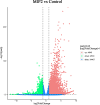Identification of the principal neuropeptide MIP and its action pathway in larval settlement of the echiuran worm Urechis unicinctus
- PMID: 38641568
- PMCID: PMC11027379
- DOI: 10.1186/s12864-024-10228-y
Identification of the principal neuropeptide MIP and its action pathway in larval settlement of the echiuran worm Urechis unicinctus
Abstract
Background: Larval settlement and metamorphosis represent critical events in the life history of marine benthic animals. Myoinhibitory peptide (MIP) plays a pivotal role in larval settlement of marine invertebrates. However, the molecular mechanisms of MIP involved in this process are not well understood.
Results: In this study, we evaluated the effects of thirteen MIP mature peptides on triggering the larval settlement of Urechis unicinctus (Xenopneusta, Urechidae), and determined that MIP2 was the principal neuropeptide. Transcriptomic analysis was employed to identify differentially expressed genes (DEGs) between the MIP2-treated larvae and normal early-segmentation larvae. Both cAMP and calcium signaling pathways were enriched in the DEGs of the MIP2-treated larvae, and two neuropeptide receptor genes (Spr, Fmrfar) were up-regulated in the MIP2-treated larvae. The activation of the SPR-cAMP pathway by MIP2 was experimentally validated in HEK293T cells. Furthermore, fourteen cilia-related genes, including Tctex1d2, Cfap45, Ift43, Ift74, Ift22, Cav1 and Mns1, etc. exhibited down-regulated expression in the MIP2-treated larvae. Whole-mount in situ hybridization identified two selected ciliary genes, Tctex1d2 and Cfap45, were specially expressed in circumoral ciliary cells of the early-segmentation larvae. Knocking down Tctex1d2 mRNA levels by in vivo RNA interference significantly increased the larval settlement rate.
Conclusion: Our findings suggest that MIP2 inhibits the function of the cilia-related genes, such as Tctex1d2, through the SPR-cAMP-PKA pathway, thereby inducing larval settlement in U. unicinctus. The study contributes important data to the understanding of neuropeptide regulation in larval settlement.
Keywords: Urechis unicinctus; Cilia-related genes; Gene pathway; Larval settlement; MIP; Neuropeptide.
© 2024. The Author(s).
Conflict of interest statement
The authors declare no competing interests.
Figures








Similar articles
-
Identification and expression analysis of receptors that mediate MIP regulating larval settlement in Urechis unicinctus.Comp Biochem Physiol B Biochem Mol Biol. 2022 Jun-Jul;260:110732. doi: 10.1016/j.cbpb.2022.110732. Epub 2022 Mar 10. Comp Biochem Physiol B Biochem Mol Biol. 2022. PMID: 35278715
-
Identification of the neuropeptide precursor genes potentially involved in the larval settlement in the Echiuran worm Urechis unicinctus.BMC Genomics. 2020 Dec 14;21(1):892. doi: 10.1186/s12864-020-07312-4. BMC Genomics. 2020. PMID: 33317448 Free PMC article.
-
Genome-wide identification and expression analysis of neuropeptide G protein-coupled receptors in Urechis unicinctus (Annelida, Echiura).Int J Biol Macromol. 2025 May;310(Pt 4):143548. doi: 10.1016/j.ijbiomac.2025.143548. Epub 2025 Apr 26. Int J Biol Macromol. 2025. PMID: 40294673
-
Love at First Taste: Induction of Larval Settlement by Marine Microbes.Int J Mol Sci. 2020 Jan 22;21(3):731. doi: 10.3390/ijms21030731. Int J Mol Sci. 2020. PMID: 31979128 Free PMC article. Review.
-
Biofilms and marine invertebrate larvae: what bacteria produce that larvae use to choose settlement sites.Ann Rev Mar Sci. 2011;3:453-70. doi: 10.1146/annurev-marine-120709-142753. Ann Rev Mar Sci. 2011. PMID: 21329213 Review.
References
-
- Toonen RJ, Pawlik JR. Foundations of gregariousness. Nature. 1994;370(6490):511–12. doi: 10.1038/370511a0. - DOI
-
- Qian PY. Larval settlement of polychaetes. Hydrobiologia. 1999;402:239–53. doi: 10.1023/A:1003704928668. - DOI
-
- Hadfield MG, Carpizo-Ituarte EG, Carmen KD, Nedved BT. Metamorphic competence, a major adaptive convergence in marine invertebrate larvae. Am Zool. 2001;41(5):1123–31.
-
- Marshall DJ, Krug PJ, Kupriyanova EK, Byrne M, Emlet RB. The biogeography of marine invertebrate life histories. Annu Rev Ecol Evol S. 2013;43:97–114. doi: 10.1146/annurev-ecolsys-102710-145004. - DOI
MeSH terms
Substances
Grants and funding
LinkOut - more resources
Full Text Sources

